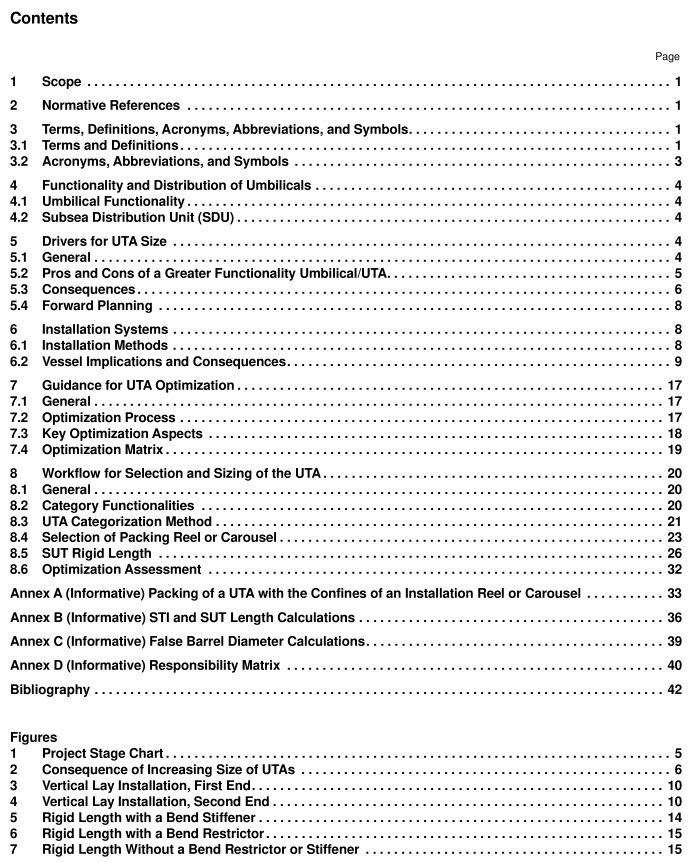API TR 17TR9 pdf download

API TR 17TR9 pdf download Umbilical Termination Assembly (UTA) Selection and Sizing Recommendations
4Functionality and Distribution of Umbilicals4.1 Umbilical Functionality
Functionality is generally limited by the actual umbilical specification rather than the UTA size.
The functionality versus umbilical limitations is evident very early in the umbilical design process.Once thefinal umbilical design specification is reached, then the design of the UTA must be fully optimized to minimizeexternal dimensions and the overall weight of the UTA(including the STl and BSR/bend restrictor weights).An important consideration to fulill the requirements of this document (also see APl 17TR10) is enablingprecise routing of functions within the UTA by having well-designed cable and fluid core distribution routes.4.2Subsea Distribution Unit (SDu)
SDUs can substantially reduce the overall UTA dimensions by encompassing the distribution paths and outletports. lt is acknowledged a separate SDU may have an impact on the overall manufacturing cost in order toconnect the units together, but the additional design and manufacture costs of separate UTA and SDuarrangements should not be the sole reason for opting for an all-encompassing UTA. Factors such ascomplicated handling, packing, transporting, increased installation costs, elevated risk of installation damage,and possible replacement of an umbilical with subsequent schedule impact must be thoroughly analyzed andassessed to make an informed decision about the split or combined arrangement of UTA and SDU. These risksshould be evaluated against the consequences associated with using a separate SDU arrangement, such asadditional equipment lead time, additional installation time, and the risk of additional subsea leak paths.
The application of this document should be from the inception of the umbilical manufacturer’s initial design.Subsequently, the UTA designers should interface closely with highly experienced installation engineers whoknow installation possibilities, lay spread,and vessel specifications. Figure 1 shows the optimum interfacingof relevant parties who will play a part in achieving a successful umbilical/UTA installation project.
The intent with describing these project stages is to clarify when within the umbilical project timeline eachumbilical termination size reduction (UMSIRE) document should be referenced and the interested parties thatshould be involved in discussions during each stage.
5 Drivers for UTA Size
5.1General
The trend of increasing functionality of topside, subsea,and downhole equipment over the past decade hascreated increasing requirements for additional fluid, electrical, and optical lines to be routed from the platformto the subsea equipment.This has resulted in a greater number of functionalities required through controlumbilicals and consequently the UTAs.
There is competition for space between umbilicals and production risers. lf it is assumed that one largeumbilical is more space efficient than multiple smaller umbilicals, then larger umbilicals are generally the bestoption.
5.2Pros and Cons of a Greater Functionality Umbilical/UTA5.2.1General
Although it is widely acknowledged that increased functionality, size, and weight of the UTA poses challengeswith installation, there are several important drivers and advantages of using umbilicals/UTAs with greaterfunctionality.lf increased functionality is balanced correctly with consideration of installation requirements andpotential difficulties,this may certainly outweigh the option with reduced functionality.This document and17TR10 will support the design evaluation process by taking into account the pros and cons of having ahigher-functionality UTA and result in a robust outcome with due consideration of risks versus costs.
5.2.2 Pros
The main advantages of a higher-functionality umbilical’UTA are as follows:
more compact subsea field layout in otherwise congested areas where multiple umbilicals may result inadditional complexity and higher risk;
less vessel time requiring subsequent installs, fewer vessels used during mobilization, does not requiresecond SDU for functionality, decrease number of flying leads;
spare philosophy for future tie-in to new step-outs,which are in approved but deferred future fieldarchitecture;









